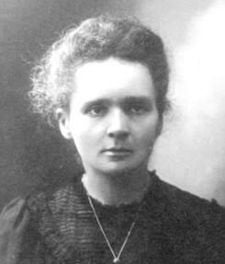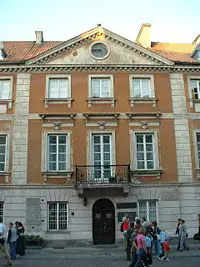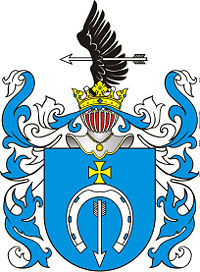Marie Curie
- This article is about the physicist and chemist Marie Curie . For the school named after her, see École élémentaire Marie-Curie.
|
Marie Curie | |
|---|---|
 Maria Skłodowska-Curie. | |
| Born |
November 7 1867 |
| Died | July 4 1934 Sancellemoz, France |
| Nationality | |
| Field | Physicist and chemist |
| Institutions | Sorbonne |
| Alma mater | Sorbonne and ESPCI |
| Academic advisor | Henri Becquerel |
| Notable students | André-Louis Debierne Marguerite Catherine Perey |
| Known for | Radioactivity |
| Notable prizes | Nobel Prize for Physics (1903) Nobel Prize for Chemistry (1911) |
| The only person to win two Nobel Prizes in different science fields. Married to Pierre Curie (m. 1895), with notable children Irène Joliot-Curie and Ève Curie. | |
Marie Curie (Polish: Maria Skłodowska-Curie, born Maria Skłodowska, November 7, 1867 – July 4, 1934) was a Polish-French physicist and chemist. She was a pioneer in the early field of radioactivity, later becoming the first two-time Nobel laureate and the only person with Nobel Prizes in two different fields of science (physics and chemistry - due to the effects of sharing, she effectively obtained 1.25 Nobel Prizes). She also became the first woman appointed to teach at the Sorbonne. She was born a Pole in Warsaw, and spent her early years there, but in 1891 at age 24, moved to France to study science in Paris. She obtained all her higher degrees and conducted her scientific career there, and became a naturalized French citizen. She founded the Curie Institutes in Paris and in Warsaw.
Biography
Born in Warsaw, Poland, then under the control of the Russian Empire, her early years were sad ones, marked by the death of her sister from typhus, and four years later, her mother. She was noted to have an amazing memory and a diligent work ethic, neglecting even food and sleep while studying. After graduating from high school at the top of her class at the age of fifteen, she was depleted of energy and was sent to the countryside to recover. Due to her gender and Russian (anti-Polish) reprisals following the January Uprising, she was not allowed admission to any university, so she worked as a governess for several years and attended the illegal Flying University. Eventually, with the monetary assistance of her elder sister Bronia, she moved to Paris. She went to high school at the Collège Sévigné, and then studied physics and mathematics at the Sorbonne, later becoming the first woman to teach there. Marie graduated first in her undergraduate class in the spring of 1893. A year later, she obtained her master's degree in mathematics, also at the Sorbonne. Under the doctoral supervision of Henri Becquerel, in 1903 she received her DSc from the ESPCI, Paris, becoming the first woman in France to complete her doctorate.
At the Sorbonne, she met and married another instructor, Pierre Curie. Together they studied radioactive materials, particularly the uranium pitchblende ore, which had the curious property of being more radioactive than the uranium extracted from it. By 1898, they deduced a logical explanation: that the pitchblende contained traces of some unknown radioactive component which was far more radioactive than uranium; thus on December 26th Marie Curie announced the existence of this new substance.
Over several years of unceasing labor, they refined several tons of pitchblende, progressively concentrating the radioactive components, and eventually isolating the chloride salts (refining radium chloride on April 20, 1902) and then two new chemical elements. The first they named polonium after Marie's native country Poland, and the other was named radium from its intense radioactivity.
Together with Pierre Curie and Henri Becquerel, she was awarded the Nobel Prize in Physics, 1903: "in recognition of the extraordinary services they have rendered by their joint researches on the radiation phenomena discovered by Professor Henri Becquerel". She was the first woman to be awarded a Nobel Prize. Eight years later, she received the Nobel Prize in Chemistry, 1911 "in recognition of her services to the advancement of chemistry by the discovery of the elements radium and polonium, by the isolation of radium and the study of the nature and compounds of this remarkable element". In an unusual move, Curie intentionally did not patent the radium isolation process, instead leaving it open so the scientific community could research unhindered. Just one month after accepting her 1911 Nobel Prize, Marie was hospitalized with depression and kidney trouble. Whenever Marie was feeling especially depressed she took a trip to the country to relax.
She was the first person to win or share two Nobel Prizes. She is one of only two people who has been awarded a Nobel Prize in two different fields, the other being Linus Pauling. As of June 2006, she remains the only woman to win two Nobel prizes.
After her husband's death from a street accident, she supposedly had an affair with physicist Paul Langevin, a married man who had left his wife, which resulted in a press scandal, exacerbated by her academic opponents in order to damage her credibility. Despite her fame as an honored scientist working for France, the public's attitude to the scandal tended towards xenophobia — she was a foreigner, from an unknown land (Poland was still referred to as a geographical area, under the Russian Tsar), an area known to have a significant Jewish population (Marie was raised as a Catholic, and was born in a gentry family [ Dołęga-Sklodowski], but she later became an atheist). France at the time was still reeling from the effects of the Dreyfus affair etc, so the scandal's effect on the public was all the more acute. It is a strange coincidence that Paul's grandson Michel later married her granddaughter Hélène Langevin-Joliot.
During World War I, she pushed for the use of mobile radiography units, named "Little Curies" (or "petites Curies"), for the treatment of wounded soldiers. These units were powered using tubes of radium emanation, a colorless, radioactive gas given off by radium, later to be identified as radon. Marie personally provided the tubes, derived from the radium she purified. Promptly after the war started, she donated her and her husband's gold Nobel Prize Medals for the war effort.
In 1921, she toured the United States, where she was welcomed triumphantly, to raise funds for research on radium.
In her later years, she was disappointed by the myriad of physicians and makers of cosmetics who used radioactive material without precautions.
Her death near Sallanches in 1934 was from aplastic anemia, almost certainly due to her massive exposure to radiation in her work, much of which was carried out in a shed with no proper safety measures being taken, as the damaging effects of hard radiation were not generally understood at that time. She was known to carry test tubes full of radioactive isotopes in her pocket, and to store them in her desk drawer, resulting in massive exposure to radiation. She was known to remark on the pretty blue-green light the metals gave off in the dark.
At first, she was buried at the same cemetery in Sceaux where Pierre lay, but in 1995 their ash was transferred to the Panthéon to honour their works.
Her eldest daughter, Irène Joliot-Curie, won a Nobel Prize for Chemistry in 1935.
Prizes
- Nobel Prize for Physics (1903)
- Davy Medal (1903)
- Matteucci Medal (1904)
- Nobel Prize for Chemistry (1911)
Tribute
Her younger daughter Eve Curie wrote the biography Madame Curie after Marie's death.
In 1995, Madame Curie was the first and only woman laid to rest under the famous dome of The Panthéon in Paris on her own merits (alongside her husband Pierre Curie).
Greer Garson and Walter Pidgeon starred in the 1943 U. S. Oscar-nominated film based on her life.
An extremely ahistorical Marie (Manya or Manyusya as it was when she was born) Curie appears as a character in the 1988 comedy Young Einstein by Yahoo Serious.
French playwright Jean-Noël Fenwick's 1989 lighthearted drama, "Les Palmes de M. Schutz," is based on the early romance and scientific collaboration of Marie and Pierre Curie. A 1997 movie version starred Isabelle Hupert as Mme. Curie.
Curie's picture was on the Polish inflationary late-1980s 20,000-zloty banknote. Her picture also appeared on the last French 500 franc note (with her husband Pierre Curie), and on stamps and coins.
Element 96 Curium (Cm) was named in honor of her and Pierre.
See also
- Maria Curie-Skłodowska University in Lublin
- Maria Skłodowska-Curie Institute of Oncology in Warsaw
- List of people on stamps of Ireland
- Marie Curie Cancer Care
Notes
Full Name: Marie Sklodowska Curie
Life Time: Born in Warsaw Poland( November 7,1867) Died in Sancellemoz, France (July 4,1934)
Career: Polish- French physicist and chemist
References and further reading
Books
- Madame Curie: A Biography, by Eve Curie, ISBN 0-306-81038-7
- Marie Curie: A Life, by Susan Quinn, ISBN 0-201-88794-0
- Obsessive Genius: The Inner World of Marie Curie, by Barbara Goldsmith, ISBN 0-393-05137-4
- The Book about Blanche and Marie, by Per Olov Enquist, ISBN 1585676683, a fictionalized account of relationships among Curie, JM Charcot and Blanche Wittman
External links
- Marie and Pierre Curie and the Discovery of Polonium and Radium unabridged spinless right chronology from nobelprize.org
- 1903 Nobel Prize in Physics and 1911 Nobel Prize in Chemistry – Nobel committee page; presentation speech, her award lecture etc.
- Concise biography at nobel-winners.com; GFDL
- The official web page of Maria Curie Skłodowska University in Lublin, Poland in English.
- Detailed Biography at Science in Poland website; with quotes, photographs, links etc.
- Long biography at American Institute of Physics website (site also has a short version for kids entitled "Her story in brief!")
- Maria Skłodowska-Curie Museum in Warsaw
- Marie Curie: A Nobel Prize Pioneer at the Panthéon
- European Marie Curie Fellowships
- Marie Curie Cancer Care, UK
- Marie Sklodowska Curie: Her Life as a Media Compendium
- Ron Schuler's Parlour Tricks: Marie Curie
- Annotated bibliography of Marie Curie from the Alsos Digital Library
- Marie Curie on the 500 French Franc and 20000 old Polish Zloty banknotes.
Credits
New World Encyclopedia writers and editors rewrote and completed the Wikipedia article in accordance with New World Encyclopedia standards. This article abides by terms of the Creative Commons CC-by-sa 3.0 License (CC-by-sa), which may be used and disseminated with proper attribution. Credit is due under the terms of this license that can reference both the New World Encyclopedia contributors and the selfless volunteer contributors of the Wikimedia Foundation. To cite this article click here for a list of acceptable citing formats.The history of earlier contributions by wikipedians is accessible to researchers here:
The history of this article since it was imported to New World Encyclopedia:
Note: Some restrictions may apply to use of individual images which are separately licensed.



